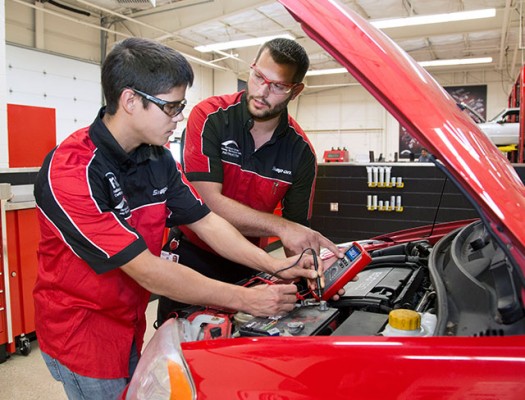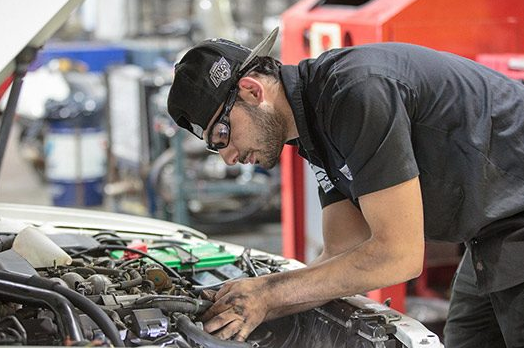What is Automotive Technology? Automotive technology encompasses the systems and innovations used in designing, building, and maintaining vehicles. This field includes advancements in safety, performance, and fuel efficiency.
Automotive technology has undergone swift transformations, making modern vehicles not just a means of transport but also a hub of connectivity and comfort. Innovations like autonomous driving, electric powertrains, and advanced driver assistance systems (ADAS) are reshaping the industry. Car manufacturers continuously integrate new technologies to enhance safety features, reduce environmental impact, and improve the overall driving experience.
Table of Contents
- 1 What is Automotive Technology? Best Informational Concept Ever
- 2 The Evolution Of Automotive Technology
- 3 Key Components Of Today’s Automobiles
- 4 Impact Of Electric Vehicles
- 5 Autonomous Driving: The Road Ahead
- 6 Future Trends And Innovations
- 7 Frequently Asked Questions Of What Is Automotive Technology
- 8 Conclusion
What is Automotive Technology? Best Informational Concept Ever
As the sector progresses, automotive professionals must stay abreast of these changes to ensure the reliability and efficiency of the vehicles they service. With each leap in technology, the automotive landscape reinvents the wheel, steering towards a future of smart, sustainable, and user-centric mobility.

Credit: alameda.edu
The Evolution Of Automotive Technology
The journey of automotive technology is nothing short of remarkable. Cars today barely resemble their ancestors from a century ago. Understanding this transformation offers a fascinating glimpse into human innovation and its impact on our daily lives. Let’s explore this exciting evolution.
Early Innovations
The dawn of automotive technology began in the late 1800s. Inventors crafted horseless carriages powered by steam engines. By the early 20th century, gasoline engines took the lead. These advancements changed how people traveled.
- 1885: Karl Benz’s Motorwagen hits the road.
- 1908: Ford Model T introduces assembly line production.
- 1920s: Electric starters, air-filled tires, and hydraulic brakes emerge.
Rise Of Electronics
Electronics started to influence car design by the 1960s. Safety and comfort became priorities. Computer chips and sensors began regulating engines. Cars got smarter and more reliable.
- Fuel injection replaced carburetors for better efficiency.
- Antilock braking systems (ABS) enhanced safety.
- Cruise control melded convenience with technology.
Modern Advancements
Today’s automotive technology is high-tech. Vehicles come packed with digital displays, connectivity, and driver-assistance systems. Electrification and autonomous driving are now defining the latest models. The future is exciting and full of possibilities.
| Year | Advancement |
|---|---|
| 2000s | Hybrid vehicles gain popularity. |
| 2010s | Electric cars become mainstream. |
| 2020s | Self-driving features are introduced. |
Key Components Of Today’s Automobiles
Understanding the intricate design and functionality of today’s automobiles is key to appreciating the marvels of modern automotive technology. From the core engine components that drive our vehicles to the advanced safety systems that protect us and the innovative infotainment that keeps us connected, today’s cars are a symphony of sophisticated technology. Let’s delve into the key components that make up the heartbeat of the modern automobile.
Engine And Powertrain Tech
The engine and powertrain are the lifeblood of an automobile, providing the necessary power to get your wheels turning. Even as electric vehicles gain traction, internal combustion engines still rule the roads. Here’s a snapshot of what sits under the hood:
- Fuel Injection Systems – Precision delivery of fuel for efficient combustion.
- Turbochargers – Boosted power for the engine without increasing its size.
- Hybrid Technologies – Combining electric and fuel power for better mileage and reduced emissions.
- Transmission Variations – Including manual, automatic, and CVTs for optimal driving control.
Safety Systems
Vehicles today are safer than ever, thanks to cutting-edge safety systems embedded throughout. These features not only help in preventing accidents but also ensure minimal damage if one occurs:
| System | Function |
|---|---|
| Anti-lock Braking System (ABS) | Prevents wheel lockup during emergency braking. |
| Traction Control | Maintains grip during acceleration. |
| Airbags | Provides cushioning and reduces impact during collisions. |
| Advanced Driver-Assistance Systems (ADAS) | Includes features like adaptive cruise control and lane-keeping assistance. |
Infotainment And Connectivity
Staying connected on the go is no longer a luxury, it’s an expectation. Modern cars deliver this with sleek infotainment and connectivity features:
- Touchscreen Displays – Interactive controls for vehicle functions and entertainment.
- Smartphone Integration – Keeps drivers connected with Apple CarPlay and Android Auto.
- WiFi Hotspots – Internet access for passengers’ devices.
- Navigation Systems – Real-time GPS guidance with live traffic updates.
Impact Of Electric Vehicles
The rise of electric vehicles (EVs) marks a major shift in automotive technology. Unlike traditional cars, EVs depend on electricity, not fuel. This change touches many parts. This includes how cars work, how we use them, and their effect on our world.
Battery Technology
Batteries are the heart of electric vehicles. They store the energy that powers the car. Recent years have seen big steps in battery life and safety.
New materials let batteries hold more power and charge faster. Car makers are now offering EVs that can go further on a single charge. This helps drivers trust electric cars more.
Charging Infrastructure
For EVs to become popular, charging must be easy. We need more places to charge EVs. Places like homes, offices, and public spaces. Governments and companies are building more charging stations. They make sure drivers can charge their vehicles quickly and everywhere they go. Charging time has also improved. Now it’s faster than ever.
Environmental Considerations
One of the biggest benefits of EVs is cleaner air. EVs don’t give off tailpipe pollution. This is good for us and the planet. But making and charging EVs does have some impact. We need to make batteries and power in cleaner ways. This will make EVs even better for the environment.
- Electric cars reduce greenhouse gases.
- Producing EV batteries can affect the environment.
- Using green energy for charging can help a lot.

Credit: www.gtc.edu
Autonomous Driving: The Road Ahead
Imagine sitting in a car that knows the route, drives you to work, and parks itself. A new era evolves; autonomous driving shapes our transportation future. Let’s explore what lies on the road ahead.
Sensor And Ai Developments
Self-driving cars rely on sensors and AI to navigate the world. In this technology leap, two elements stand out:
- Sensors: They are the car’s eyes and ears. Lidar, cameras, and radar paint a digital picture of the surroundings.
- AI: The brain that interprets sensor data, makes decisions, and learns from experiences.
Steady progress in AI algorithms and sensor accuracy is crucial. It ensures safe and efficient autonomous travel.
Legislative Challenges
Rules and laws must adapt for self-driving cars. Key points include:
| Focus Area | Legislative Consideration |
|---|---|
| Liability | Who is responsible when an autonomous vehicle is involved in an incident? |
| Standards | What safety and operation benchmarks must these vehicles meet? |
| Integration | How will autonomous vehicles coexist with traditional vehicles on the road? |
Clear regulations support innovation while ensuring public safety.
Potential Societal Changes
Driverless cars promise vast social shifts. Some of these changes include:
- Reduced accidents due to human error, leading to safer roads.
- More accessible transportation for the elderly and disabled.
- New urban designs, with less need for parking spaces.
- Environmental benefits from optimized driving patterns.
Adapting to these changes requires planning. It also brings exciting prospects for a transformed society.
Future Trends And Innovations
The realm of automotive technology is accelerating at breakneck speed. Innovations on the horizon promise enhanced efficiency and revolutionary communication. Here are key trends set to redefine the future of driving.
Hydrogen Fuel Cells
Hydrogen fuel cells stand at the forefront of green automotive solutions. These cells power electric vehicles with water vapor as the only byproduct. They offer quick refueling and extended range, presenting a compelling alternative to traditional combustion engines and battery options. Experts project a surge in hydrogen infrastructure, making these vehicles more accessible.
Vehicle-to-vehicle Communication
Imagine cars that ‘talk’ to each other. Vehicle-to-Vehicle (V2V) communication is making this a reality. This technology allows cars to share information about speed and positioning. It helps prevent accidents by alerting drivers about potential hazards. Future roads will be safer as vehicles communicate to maintain distance and optimize traffic flow.
Augmented Reality Dashboards
We are on the verge of witnessing Augmented Reality (AR) dashboards transform the driving experience. These high-tech displays provide real-time information overlaid on the windshield. Drivers can see navigation cues, hazard warnings, and vehicle data without looking away from the road. AR dashboards blend information seamlessly into the driving view, enhancing safety and convenience.

Credit: www.neit.edu
Frequently Asked Questions Of What Is Automotive Technology
Is Automotive Technology The Same As A Mechanic?
Automotive technology encompasses a broader field, including design, development, and production of vehicles, whereas a mechanic specifically repairs and maintains vehicles.
What Is The Basic Of Automotive Technology?
The basics of automotive technology involve understanding vehicle systems like engines, transmissions, brakes, and electronics. It encompasses the study of how these components work together to ensure safe, efficient operation.
Is A Degree In Automotive Technology Worth It?
Achieving a degree in automotive technology can be valuable, offering practical skills for a career in vehicle maintenance and repair. Demand for qualified automotive technicians remains high, potentially leading to stable job opportunities and competitive salaries.
What Is The Job Description Of Automotive Technology?
An automotive technology job involves diagnosing, repairing, and maintaining vehicles. Technicians work on engines, electrical systems, and other car components, often using computerized tools. They must stay current with evolving vehicle technology.
Conclusion
Embracing automotive technology is pivotal in driving innovation forward. Whether it’s enhancing safety, boosting efficiency, or delivering sheer driving pleasure, its impact is profound. As vehicles evolve, staying abreast of these advancements becomes not just fascinating, but essential. Dive in, the future of motoring beckons with promise and excitement.
